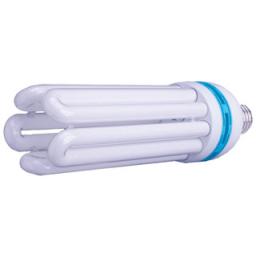In my opinion, there’s a good case to be made for the humble light-emitting diode to be the third most important invention of the twentieth century. The first would have to be the internet (some have called this as important as the wheel and the taming of fire), second the semiconductor which is the basis of every electronic device currently made, and I’d put the LED third. You are surrounded by thousands of them, in your phone, monitor, every single device that has a power light… it’s impossible to imagine life without them at this point. Without the LED nothing would be as light and thin as it is today. Simple as that.
The real magic of the LED is that is is so much brighter than an incandescent bulb of similar size. It’s actually possible to make very small incandescent bulbs, but they’re dim and easily breakable, as anyone who’s ever decorated a Christmas tree will tell you. And really, LEDs can be tiny; the actual hardware part can be smaller than the head of a pin. Most of what you see in an LED is a lens designed to focus the light outward and also make it large enough for people to handle.
Yet, it’s not really accurate to say LEDs are brighter than any other kind of light source. It’s much more accurate to say they are more efficient. The difference is that an LED gives off light directly, with almost no intermediate step and very little waste compared to other light sources. Let me explain.
Before LED’s…

The first light source that we as humans learned to control was fire. Light something on fire, whether it’s a stick or a bag of gas, and it will light up the room. The thing is, though, the light isn’t really the purpose of the fire. The fire is consuming whatever it is (wood, candle wick, kerosene, whatever) and light is a byproduct. It’s not the main point. So depending on what you’re burning, about 90% of the energy that’s released is something that isn’t light. It’s heat, it’s other forms of radiation, it’s the kinetic energy of the remaining particles (ash and such.) Light’s just the part we care about, but it’s not really the biggest part of the whole fire experience.
And then a light bulb went off…

Incandescent light bulbs aren’t really too different from fire, and like fire you get a lot of stuff happening that isn’t light. When electricity is passed through a metal wire, resistance causes that electricity to be converted to radiation, mostly heat and light. This is more efficient than actually burning things, but not much. You get a lot of heat with a light bulb, which you already knew. Incandescent lights just aren’t very efficient either, although they’re more efficient than fire.
Compact Fluorescents

Fluorescent bulbs are more efficient than incandescents. High-voltage electricity passes through a gas and makes it glow. Because more of the energy goes into light, you get a better “bang for the buck.” The problem with fluorescents is that you have to convert your regular home voltage to very high voltage and that wastes some energy. It also creates a failure point.
Finally, LEDs come into play

Where the LED really shines (pun intended) is its efficiency. You start with a low-voltage power source, pass it through a specific solid element, and you get light. You get a lot of light, very little heat, and not a lot of other byproducts. LEDs are much much more efficient than any other light source and because they’re also smaller, they can be used in all sorts of ways that other light sources can’t, for example in smartphones.
LED’s aren’t perfect, though. When you’re talking about LED lights that are bright enough to use for light bulbs, they put out enough heat that it effects their lifespan. An LED indicator light could last 200,000 hours, but a LED light bulb lasts maybe only 20,000. That’s still an amazing time period but it’s less than you’d get with a dimmer bulb.
LEDs also have a problem with color. LEDs themselves put out a very pure color, which is why blue LEDs are so piercing. However, white light isn’t pure — it’s a mix of all the other colors. In order to get a white light LED you end up mixing technology from red, green and blue LEDs so this increases cost and decreases efficiency. Even so, white LEDs are taking off as prices drop.
The humble little light-emitting diode does a huge amount of work for you, and it does it very efficiently. It’s not perfect, just close.
Solid Signal doesn’t sell LED bulbs, but we do sell a lot of other stuff to help you live your best digital life. Shop now at SolidSignal.com or call 888-233-7563 for the best tech support!

